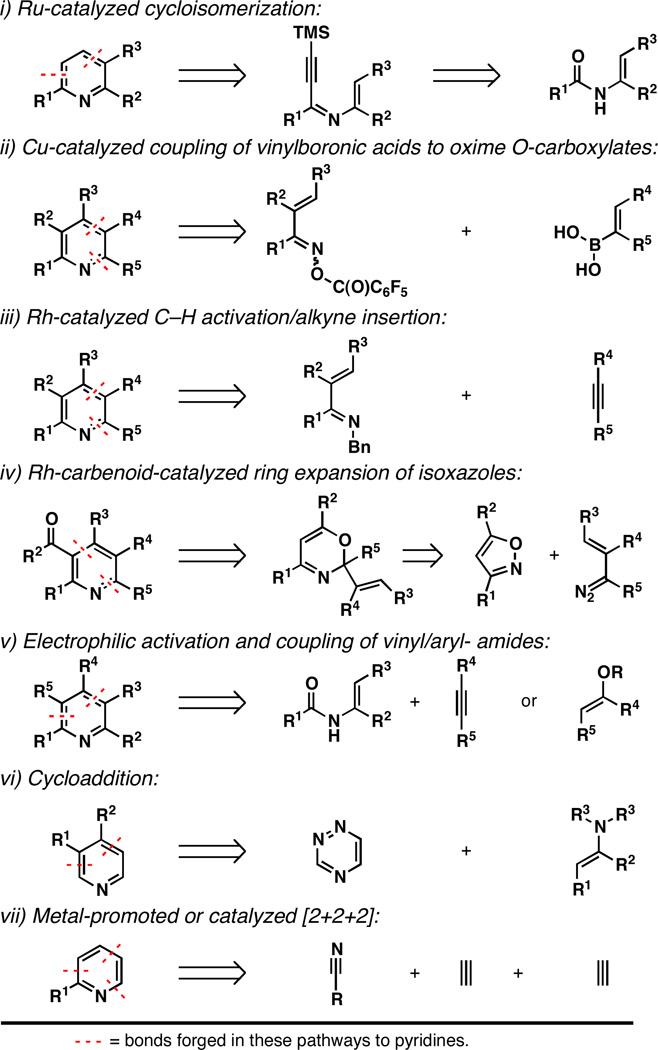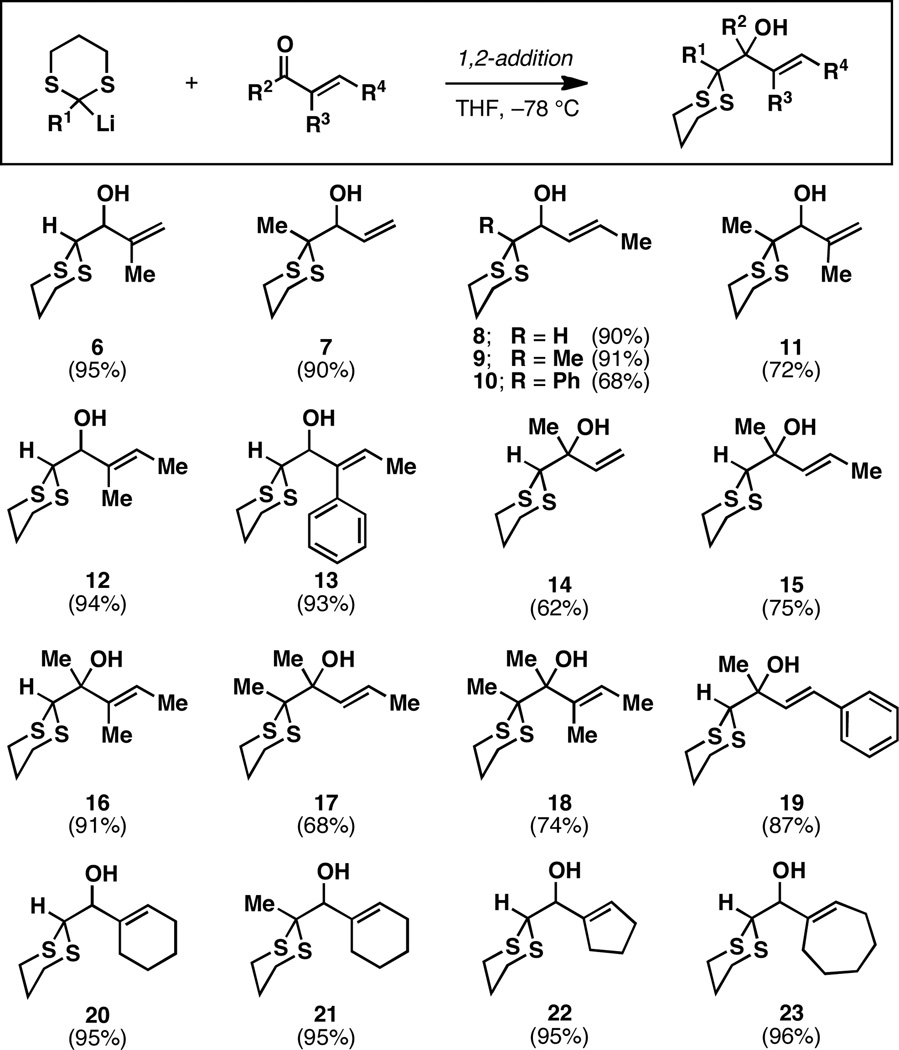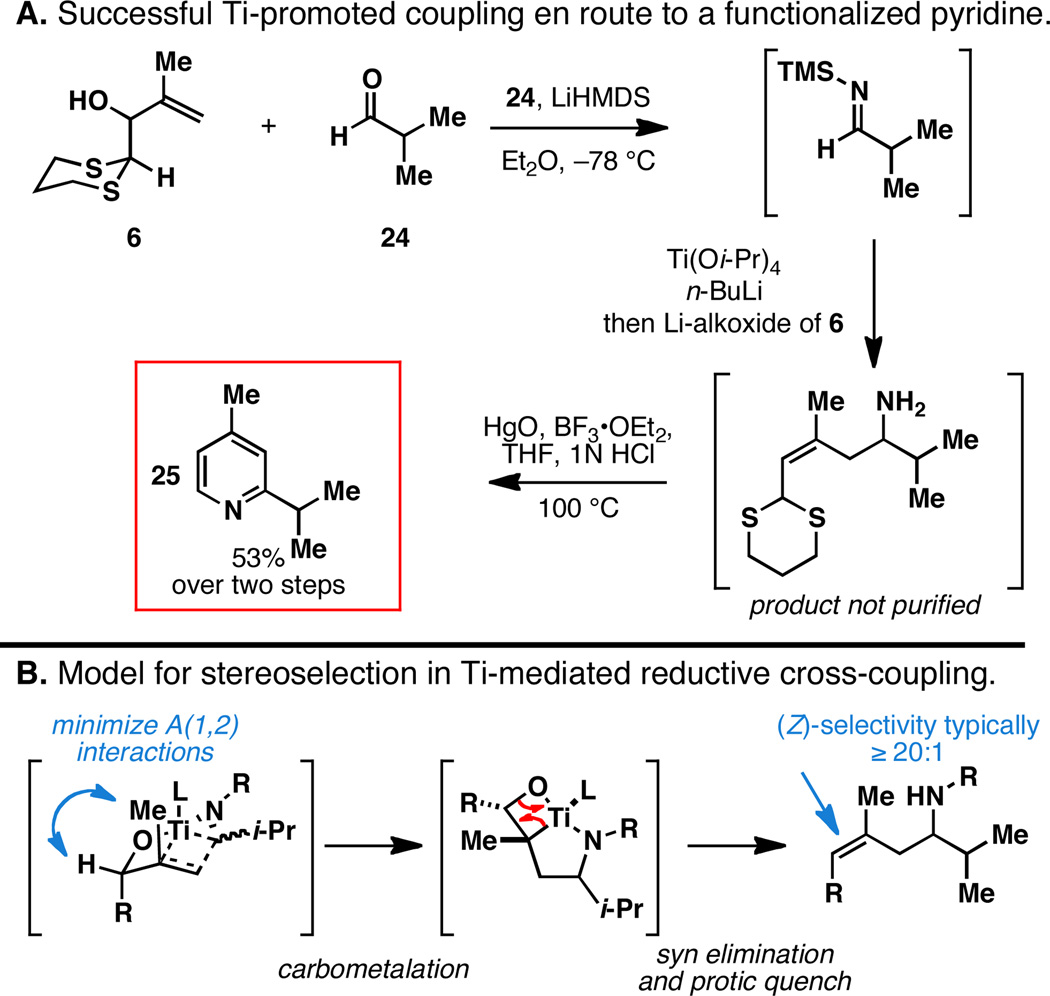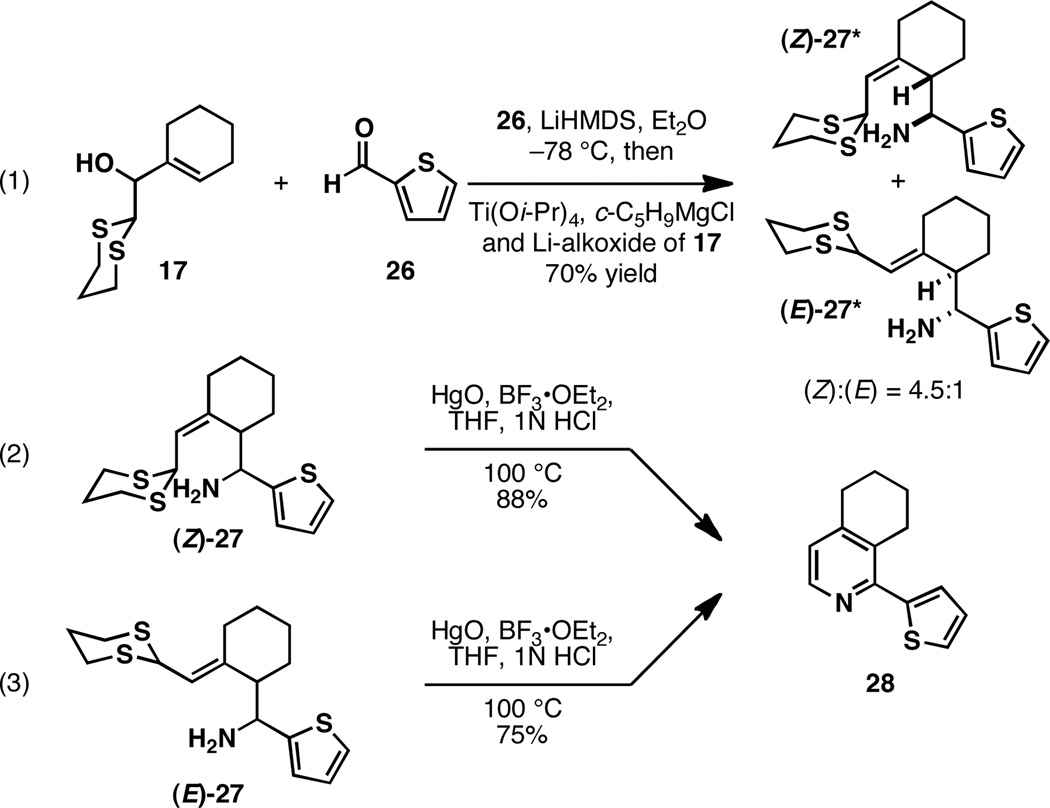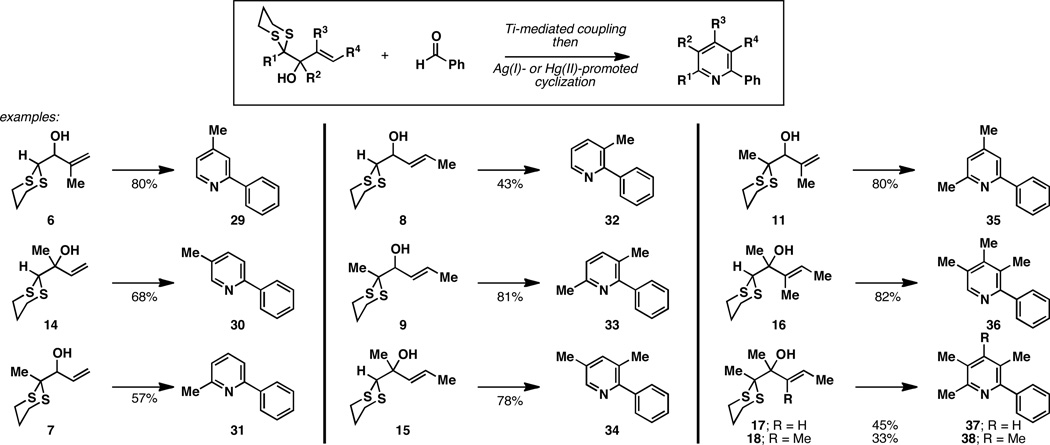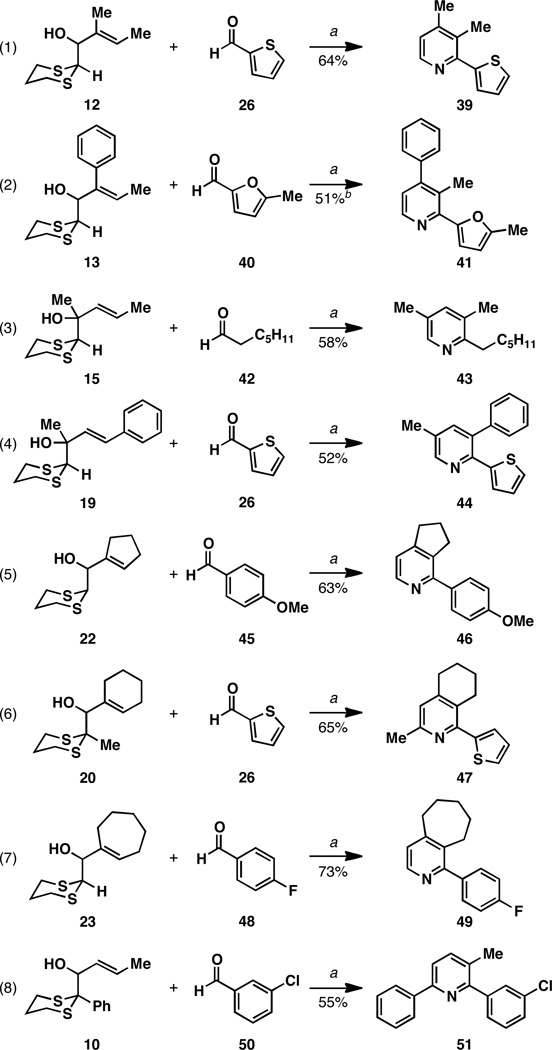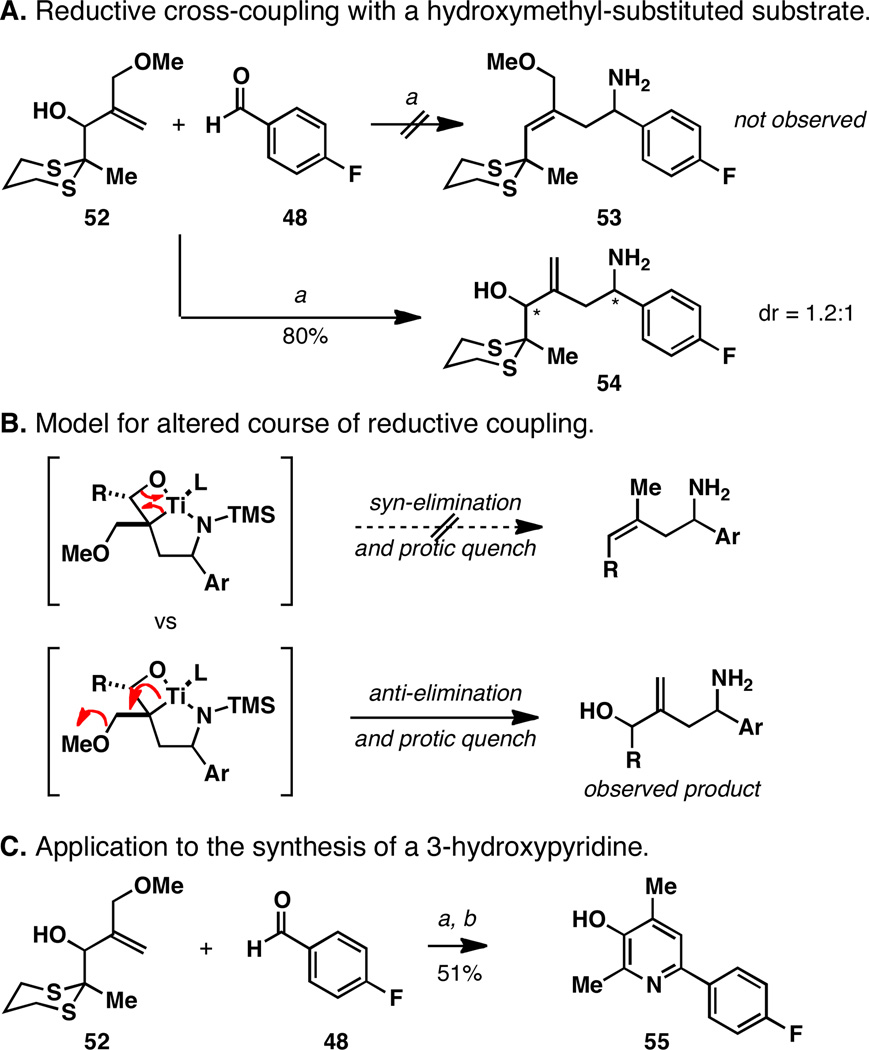Abstract
A de novo synthesis of substituted pyridines is described that proceeds through nucleophilic addition of a dithiane anion to an α,β-unsaturated carbonyl followed by metallacycle-mediated union of the resulting allylic alcohol with preformed TMS-imines (generated in situ by the low temperature reaction of LiHMDS with an aldehyde) and Ag(I)-, or Hg(II)-mediated ring closure. The process is useful for the convergent assembly of di- through penta-substituted pyridines with complete regiochemical control.
INTRODUCTION
Aromatic nitrogen heterocycles play prominent roles in natural products and pharmaceutical agents. Of these, substituted pyridines are particularly abundant.1 As a result, pyridine synthesis has attracted the attention of members of the scientific community for more than 140 years. While many chemical methods exist for the preparation of these heteroaromatics, the search for new strategies that offer concise and regiospecific access remain a topic of considerable interest.1
With our sights set on the development of a highly convergent pyridine synthesis that proceeds from readily available starting materials, we have focused on realization of the retro-synthetic strategy depicted in Figure 1. Here, four central bonds of the pyridine are targeted for synthesis via stepwise union of an aldehyde 2, an α,β-unsaturated carbonyl system 3, and a dithiane 4 through a process that delivers pyridine products as single regioisomers.
Figure 1.
A new approach to pyridine synthesis by metallacycle-mediated C–C bond formation.
This proposed strategy marks a substantial departure from traditional approaches based on carbonyl condensation chemistry (i.e. Hantzch-like dihydropyridine synthesis)2 and offers great flexibility in the nature and substitution of the pyridine products that can be accessed. Aside from the present study, a great many modern advances have been described that provide access to substituted pyridines by synthesis strategies that embrace a variety of diverse modes of chemical reactivity and key bond forming reactions that are distinct from those under pursuit. As illustrated in Figure 2, these include Ru-catalyzed cycloisomerization,3 Cu-catalyzed cross-coupling of vinylboronic acids and oxime O-carboxylates,4 Rh-catalyzed C–H activation/alkyne insertion,5 Rh-carbenoid-catalyzed ring expansion of isoxazoles,6 electrophilic activation of vinyl-/aryl-amides and subsequent coupling with π-nucleophiles,7 cycloaddition,8 and ring closing metathesis9 (not depicted).
Figure 2.
Some modern strategies for de novo pyridine synthesis.
Distinct from these are Reppe-inspired syntheses of pyridines that proceed by metallacycle-mediated union of alkynes with a nitrile via [2+2+2] chemistry (Figure 2-vii).10 While elegant and highly convergent, these metallacycle-mediated processes remain substantially limited in scope, suffering from the great challenges associated with controlling regioselectivity in metallacycle-mediated [2+2+2] annulation.11
In a strategically distinct approach to metallacycle-mediated pyridine synthesis that does not proceed by [2+2+2] annulation, we aimed to accomplish a simple, modular and regio-specific three-component coupling sequence. As illustrated in Figure 3, substituted pyrdines (1) were envisioned to derive from Hg(II)- or Ag(I)-mediated cyclization of a suitably functionalized primary homoallylic amine A, itself derived from the metallacycle-mediated union of an aldehyde 2 with LiHMDS and a dithiane-containing allylic alcohol 5.12 This latter coupling partner was thought to be readily available from selective 1,2-addition of a dithiane anion (4) to an α,β-unsaturated carbonyl system (3).
Figure 3.
Concerns regarding reactivity and selectivity.
While built on our recently described three-component coupling reaction for the synthesis of primary homoallylic amines from the union of aldehydes with LiHMDS and an allylic alcohol,12 the current pursuit was aimed at accomplishing a significantly more demanding process. The increased challenges associated with this pursuit span considerations regarding both reactivity and stereoselectivity. First, chemical compatibility of the dithiane group of 5 with the reaction conditions for Timediated coupling was thought to define a potential barrier to success. It is well established that low-valent Ti-reagents (specifically, Cp2Ti-) are capable of converting dithianes to the corresponding metal-carbene, and elegant examples of this process have been employed in synthesis campaigns.13 Second, our established Ti-mediated allylic alcohol–imine coupling process is not uniformly (Z)-selective. If (Z)-selectivity in the union of 2 and 5 is necessary to enable subsequent ring closure/oxidation to the pyridine, then only a small subset of substituted allylic alcohols would be of utility in this process (R3 ≠ H; R2 = H).14 As such, the general strategy depicted in Figure 3 had the potential of being rather limited in its ability to access a range of substituted pyridines. That said, if conditions for cyclization could be found to enable rapid and reversible alkene isomerization prior to ring closure, the strategy depicted in Figure 3 would be of extremely broad utility as a means to access a great variety of differentially substituted pyridines.
Following, is a description of our studies focused on the realization of this approach to de novo pyridine synthesis that documents the compatibility of a dithiane with the targeted Timediated bond construction (5 + 2 → A; Figure 3), and the ability to advance (E)- or (Z)-alkene-containing homoallylic amines to a wide range of subsistuted pyridine products (A → 1).
RESULTS
The first step of this three-component coupling strategy to de novo pyridines based on selective 1,2-addition of a dithiane anion to an α,β-unsaturated ketone or aldehyde typically proceeds with very high levels of efficiency. As depicted in Figure 4, a range of substituted allylic alcohols can be prepared by this process including those that contain secondary and tertiary alcohols as well as mono-, di- and tri-substituted alkenes (6–23).
Figure 4.
Step 1 – 1,2-addition of dithiane anions to α,β-unsaturated aldehydes and ketones. Reaction conditions: n-BuLi, dithiane, THF (−20 °C), then −78 °C and add aldehyde or ketone.
With sights now set on the metallacycle-mediated coupling step of the planned pyridine synthesis, we examined the reactivity of allylic alcohol 6 in Ti-mediated reductive cross-coupling with aldehyde 24 (Figure 5A). Here, we were delighted to find that convergent coupling proceeded effectively, despite the presence of the dithiane, and the primary homoallylic amine product was advanced to the 2,4-disubstituted pyridine 25 in 53% yield (over the two-step sequence) as a single substitutional isomer. While we did not isolate the proposed homoallylic amine intermediate in this sequence, previous experiences14 with Ti-mediated reductive cross-coupling reactions of related allylic alcohol (i.e. those containing 1,1-disubstituted alkenes) led to the expectation that this coupling reaction proceeds with very high levels of (Z)-selectivity (Figure 5B).
Figure 5.
Initial success in Ti-mediated coupling and Hg-mediated cyclization.
Moving on, we explored the role of alkene geometry in the Hg(II)-promoted ketal removal/cyclization and subsequent aromatization process. As depicted in eq 1 of Figure 6, reductive cross-coupling of the cyclohexenyl-containing allylic alcohol 17 with the heteroaromatic aldehyde 26 proceeds with modest stereoselection to deliver a mixture of two isomeric products 27 (Z:E = 4.5:1). Upon separation of this product mixture, each isomer was successfully converted to the hydroisoquinoline 28 with similar efficiencies (75 and 88% yields; eqs 2 and 3).
Figure 6.
Alkene geometry is not relevant in the pyridine forming sequence. * = relative sp3 stereochemistry of products (Z)-27 and (E)-27 was not determined. Relative stereochemistry depicted for these isomers was assigned from our empirical model.14
This finding, that alkene geometry does not play an important role in the pyridine-forming process, has profound impact on the potential utility of this general strategy to pyridine synthesis. Being unbound by a specific allylic alcohol substitution pattern as a means to render the reductive cross-coupling (Z)-selective, this approach to pyridine synthesis can embrace the participation of a host of substrates that contain widely varying substitution about the central allylic alcohol motif. As a result, this pyridine synthesis provides regiospecific access to a great variety of differentially substituted systems. As illustrated in Figure 7, coupling reactions employing benzaldehyde result in the generation of a range of 2-Ph-substituted pyridines that span disubstituted [2,4- (29), 2,5- (30), 2,6- (31), 2,3- (32)], trisubstituted [2,3,5- (33), 2,3,4- (34), 2,4,6- (35)], tetrasubstituted [2,3,4,5- (36), 2,3,5,6- (37)], and even pentasubstituted (38) products.
Figure 7.
Regiospecific entry to a range of 2-Ph-substituted pyridines. Reaction conditions: (1) Ti-mediated coupling – aldehyde (2 eq), LiHMDS, Et2O, then Ti(Oi-Pr)4, c-C5H9MgCl or n-BuLi, then add Li-alkoxide of allylic alcohol (1 eq); (2) cyclization – HgO, BF3•OEt2, HCl, THF (100 °C).
With a firm foundation of results supporting the great flexibility of this pyridine synthesis for the preparation of 2-Ph-substituted pyridines, effort was focused on exploring the suitability of this process for preparing pyridine analogs that contain varying substituents about the heterocycle core. As illustrated in Figure 8, eqs 1–8, a range of substituted mono- and bicyclic pyridines are easily accessible from the Ti-mediated reductive cross-coupling/cyclization sequence of aromatic and aliphatic aldehydes with suitably functionalized allylic alcohols. Overall, the substituted pyridine products from this process contain additional heteroaromatics [i.e. thiophenes (39, 44 and 47) and furans (41)], electron rich and electron poor aromatics [including arylfluorides (49) and arylchlorides(51)], as well as aliphatic groups (43) and fused ring systems (46, 47, and 49).
Figure 8.
Exploring the scope of this metallacycle-mediated approach to de novo pyridine synthesis. Reaction conditions: (a) Timediated coupling – aldehyde (2 eq), LiHMDS, Et2O, then Ti(Oi-Pr)4, c-C5H9MgCl or n-BuLi, then add Li-alkoxide of allylic alcohol (1 eq); cyclization – HgO, BF3•OEt2, HCl, THF (100 °C); (b) AgNO3 was employed for the cyclization step: AgNO3, THF, H2O (60 °C).
In an attempt to expand the scope of this process to include heteroatom-substituted pyridine products, we have discovered a novel mode of reactivity associated with the Ti-mediated reductive cross-coupling process. As depicted in Figure 9A, coupling of aldehyde 48 with allylic alcohol 52 does not deliver the expected product of reductive cross-coupling 53. Rather, convergent union delivers the 1,4-amino alcohol product 54 in 80% yield (as a 1.2:1 mixture of stereoisomers).15 This surprising result is rationalized by the empirical model depicted in Figure 9B. Directed carbometalation ensues to deliver a fused bicyclic azametallacycle that has the potential to eliminate by either: 1) syn-elimination (as expected), or 2) anti-elimination of the methyl ether. It is this latter pathway that is thought to result in the unexpected product 54. While not a central focus of this study, we are quite interested in this alternative reaction pathway for metallacycle-mediated reductive cross-coupling and anticipate further study outside of the context of our interest in pyridine synthesis. Nevertheless, this surprising observation regarding the course of reductive cross-coupling, this process serves as a suitable entry to 3-hydroxypyridines as depicted in Figure 9C.
Figure 9.
A pathway to 3-hydroxypyridines. : (a) aldehyde (2 eq), LiHMDS, Et2O, then Ti(Oi-Pr)4, c-C5H9MgCl or n-BuLi, then add Li-alkoxide of allylic alcohol (1 eq); (b) HgO, BF3•OEt2, HCl, THF (100 °C).
CONCLUSION
Overall, we report a convergent de novo pyridine synthesis that proceeds via metallacycle-mediated union of readily available allylic alcohols and aldehydes. Our successes in these studies have defined a particularly powerful entry to this heterocyclic motif that appears well suited for the synthesis of pyridines bearing a great variety of substitution pattern. Unlike established metallacycle-mediated pathways to pyridines that proceed by [2+2+2] annulation, the current contribution defines a regiospecific approach to the synthesis of differentially functionalized systems.
Supplementary Material
ACKNOWLEDGMENT
We gratefully acknowledge financial support of this work by the National Institutes of Health –NIGMS (GM80266 and GM80266-04S1).
Footnotes
SUPPORTING INFORMATION PARAGRAPH:
Experimental procedures and tabulated spectroscopic data for new compounds (PDF) are available free of charge via the Internet at http://pubs.acs.org/paragonplus/submission/jacsat/.
REFERENCES
- 1.For a recent review, see: Henry GD. Tetrahedron. 2004;60:6043–6061.
- 2.Name Reactions in Heterocycle Synthesis; Li JJ, Corey EJ, editors. New York: Wiley; 2005. p. 558.
- 3.Movassaghi M, Hill MD. J. Am. Chem. Soc. 2006;128:4592–4593. doi: 10.1021/ja060626a. [DOI] [PubMed] [Google Scholar]
- 4.Liu S, Liebeskind LS. J. Am. Chem. Soc. 2008;130:6918–6919. doi: 10.1021/ja8013743. [DOI] [PMC free article] [PubMed] [Google Scholar]
- 5.Colby DA, Bergman RG, Ellman JA. J. Am. Chem. Soc. 2008;130:3645–3651. doi: 10.1021/ja7104784. [DOI] [PMC free article] [PubMed] [Google Scholar]
- 6.Manning JR, Davies HML. J. Am. Chem. Soc. 2008;130:8602–8603. doi: 10.1021/ja803139k. [DOI] [PMC free article] [PubMed] [Google Scholar]
- 7.Movassaghi M, Hill MD, Ahmad OK. J. Am. Chem. Soc. 2007;129:10096–10097. doi: 10.1021/ja073912a. [DOI] [PubMed] [Google Scholar]
- 8.Boger DL. Chem. Rev. 1986;86:781–793. [Google Scholar]
- 9.a) Donohoe TJ, Fishlock LP, Basutto JA, Bower JF, Procopiou PA, Thompson AL. Chemical Commun. 2009:3008–3010. doi: 10.1039/b904363b. [DOI] [PubMed] [Google Scholar]; b) Donohoe TJ, Basutto JA, Bower JF, Rathi A. Org. Lett. 2011;13:1036–1039. doi: 10.1021/ol103088r. [DOI] [PubMed] [Google Scholar]
- 10.For a review, see: Vollhardt KPC. Angew. Chem. Int. Ed. Engl. 1984;23:539–556.
- 11.For a Ti(Oi-Pr)4-mediated regioselective route to pyridines by [2+2+2] between a terminal alkyne, internal alkyne and nitrile, see: Suzuki D, Tanaka R, Urabe H, Sato F. J. Am. Chem. Soc. 2002;124:3518–3519. doi: 10.1021/ja017766z. Suzuki D, Nobe Y, Watai Y, Tanaka R, Takayama Y, Sato F, Urabe H. J. Am. Chem. Soc. 2005;127:7474–7479. doi: 10.1021/ja0502730. For a recent review of Cp2Zr-mediated [2+2+2] for pyridine synthesis, see: Zhou L, Yamanaka M, Kanno K, Takahashi T. Heterocycles. 2008;76:923–947.
- 12.Yang D, Micalizio GC. J. Am. Chem. Soc. 2011;133:9216–9219. doi: 10.1021/ja202900h. [DOI] [PMC free article] [PubMed] [Google Scholar]
- 13.For a review of Ti(II)-mediated conversion of dithioacetals to Ti carbene complexes, see: Takeda T. Chem. Rec. 2007;7:24–36. doi: 10.1002/tcr.20103.
- 14.For a detailed discussion of stereoselectivity in metallacycle-mediated allylic alcohol–imine coupling, see: Chen MZ, McLaughlin M, Takahashi M, Tarselli MA, Yang D, Umemura S, Micalizio GC. J. Org. Chem. 2010;75:8048–8059. doi: 10.1021/jo101535d.
- 15.The stereochemistry of these isomers was not assigned.
Associated Data
This section collects any data citations, data availability statements, or supplementary materials included in this article.




